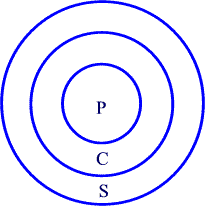|
Theory Guides - Anti-Oppressive Practice Exploring
anti-oppressive practice: Thompson’s PCS Model According
to Thompson (1997), the workings of
oppression can be analysed using a model that examines three levels –
P (personal) C (cultural)
and S (structural):
Personal
(P) Level This
is normally concerned with an individual’s views, particularly in the case of
a prejudice against a certain group of people. For example, this could relate to
a young person who makes racist comments. It is purely related to individual actions and you are likely to come into contact with this
in practice. The ‘P’ is located in the middle of the diagram, because that
individual has his beliefs and ideas supported through two other levels... Cultural
(C) Level This
analysis relates to the ‘shared values’ or ‘commonalties’. For example,
shared beliefs about what is right and wrong, good or bad, can form a consensus.
Structural
(S) Level This
analysis demonstrates how oppression is ‘sewn into the fabric’ of society
through institutions that support both cultural norms and personal beliefs. Some
institutions such as sections of the media, religion and the government can
cement the beliefs. Example:
Homophobia Legalised P:
Young man in the club you work at makes offensive and derogatory comments about
a gay man who attends also. He says that ‘gay people are not natural’ or
‘normal’. C:
Gay people largely repulse the community around him, and many of the community
members are involved with the local church, holding firm views about 'sexual
morals'. S:
Popular tabloid media berates the ‘abnormal’ activities of gay people.
Religious leaders of all faiths support the instatement of laws to stop equal
rights for gay people. Legislation is passed by parliament that compromises the
rights of gay, lesbian and bisexual people. There is an overwhelming 'consensus'
of power used in all forms of structural life. How
this analysis can help youth workers This
analysis may help you to build an idea of why young people behave in certain
ways – or why they carry out such actions. It can also give you ground for
challenging inequality. By first fully identifying what drives people to hold
‘prejudices’. It reminds us that society enforces a lot of our beliefs –
helps us to understand how something can become a ‘norm’ and how best we can
go about explaining, and challenging, oppression. Testing
the model Try
to think of a commonly held assumption that you, or someone you know, hold to be
true. From this, see if it is a shared view in anyway. Then begin to see how
national institutions, such as the newspaper you read or a television programme
you watch could help to support your views. Further
reading On
the site: Agents
of Surveillance by Jason Wood
explores the PCS model in relation to youth work Anti-oppressive
case-study by Jay Patel
shows how anti-oppressive practice can be implemented Change
Agent in Conflict by Jason Wood
explores the conflicts facing youth workers in terms of the 'structure' In
print: Thompson,
N. (1997) Anti-discriminatory Practice (2nd
Ed), Basingstoke: Macmillan Chapter
2 deals particularly with the theory base of oppression and explores the PCS in
some length. Written by Jason Wood, August 2001 Please
always reference the author of this page. How
to reference us.
|
